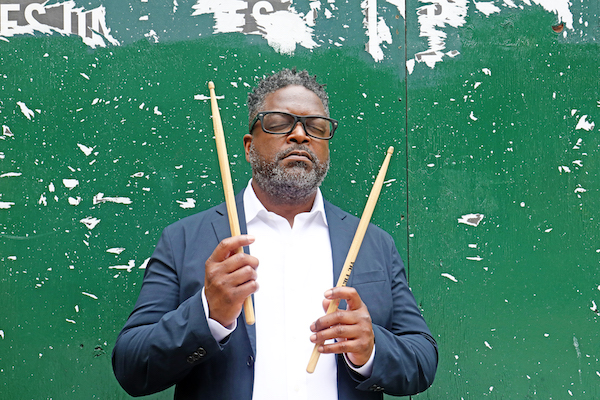Oct 28, 2025 10:47 AM
In Memoriam: Jack DeJohnette, 1942–2025
Jack DeJohnette, a bold and resourceful drummer and NEA Jazz Master who forged a unique vocabulary on the kit over his…

Drummer Gerald Cleaver works with some of today’s most fearless musicians.
(Photo: Chris Drukker)Drummer Gerald Cleaver unfairly has been pigeonholed as a free-jazz player for much of his career, though his efforts as a bandleader and composer provide much more than that.
Live At Firehouse 12 arrives a dozen years after the agile hard-bop sextet Violet Hour made its debut on Gerald Cleaver’s Detroit. For those more accustomed to Cleaver’s free drumming, it might come as a shock. Surrounded by bassist Chris Lightcap, pianist Ben Waltzer, saxophonist and clarinetist Andrew Bishop, tenor saxophonist JD Allen and trumpeter Jeremy Pelt, the bandleader takes his combo through five soulful originals informed by classic ’50s tropes, characterized by a deceptively fluid, post-bop expressionism and fine-tuned interplay. The polyphony and pulse-quickening tempo shifts on a piece like “Silly One” rely on high-wire chemistry among band members, with heady stop-on-a-dime groove alterations that sound deceptively easy in the hands of these players.
The music on Live At Firehouse 12 (Sunnyside) actually was recorded in 2006, before the band entered the studio for its first album, but it’s only now seeing the light of day. The drummer came across the recording on his computer, reviving his love for the project, which ends a five-year hiatus with a series of gigs in East Lansing and Ann Arbor, Michigan, and at Smalls in New York during January.
“For three months, I really listened to it and I realized in certain ways it was a lot freer and reflected the nature of that band [more than Detroit],” Cleaver said recently. “It just went into hibernation. We all really love playing with each other, and all of my projects are sort of rolling things that I like to revisit from time to time.”
Cleaver long ago achieved elevated status as one of the most versatile drummers in jazz and improvised music, a performer blind to the often-arbitrary lines that distinguish schools of musical thought. He sounds just as comfortable and authoritative in bands that swing as he does in groups that play abstractly, and he’s been gracefully straddling those aesthetic worlds since emerging from his native Detroit in a late-1990s band led by bassist Rodney Whitaker.
Allen was only 16 when he first worked with Cleaver in that band, and they’ve maintained a deep connection ever since.
“Gerald is a perfect example of the Detroit style of playing jazz, at least the generation that I came up in,” Allen said. “He walks in all of the styles of jazz. Once we were playing with Jeremy Pelt somewhere in Germany, and this person from the audience comes up to Gerald after and said, ‘Gerald, I’m so surprised to hear you play straightahead jazz.’ Gerald calmly replied, ‘It all comes from the same source; it’s all one.’ He’s my prototype for drummers.”
While Cleaver is a ubiquitous collaborator, working with some of today’s most fearless musicians—including saxophonists like Angelika Niescier and Ivo Perelman, pianist Craig Taborn and bassist William Parker—he’s been judicious as a bandleader.
“At this point, I’m only doing things that I love, and I don’t feel a pressing need to be a leader in a strict sense,” he said. “That frees me up. Being a sideman informs me just as much as plumbing the depths of my own individual creativity. Given the amount of experience I have and where I’m at in my career, honestly, I don’t feel any difference between the leader projects I do and the sideman projects I do, because everyone that hires me, hires me for me. I’m able to express myself in a really honest fashion.”
For Cleaver, working with other leaders is just as gratifying as his own projects, which also include the bruising, rock-flavored Black Host, which formed around 2011, and Farmers by Nature, his protean improvising trio with Taborn and Parker that was inaugurated in 2007.
“From my perspective all of the projects run into one another,” Cleaver said. “With any ensemble, I put myself into a different context, like a game. In free playing—which is a term I don’t really like, although I don’t have an alternative—everything comes to mind, all types of music within that spontaneous creation: swinging, density, melody, harmony. These are all things that I’m doing, but it’s just coming from the drum set. I’m hearing those sorts of things and I’m applying them to different contexts.”
Still, in early 2020 Cleaver will unveil a new side of his ever-evolving practice with Signs (577), an album of electronic music he created in his Brooklyn home where aqueous textures, peripatetic rhythms and colliding melodic impulses blend with the same multifarious aesthetic of his work behind the kit.
“I always liked the sound and the possibilities that were achieved by electronic music, so it was something I needed to learn,” Cleaver said. “I felt I had a pretty good handle on actual interaction with human beings, so I was trying to expand my palette and put my voice into this type of technology. My dabbling with electronic music goes back to Black Host, but I was at a very basic level when I did that, so this is a full realization of that aspect of my music-making.”
Next year, Cleaver plans to work on new recordings by Black Host—a hard-hitting quintet with guitarist Brandon Seabrook, bassist Pascal Niggenkemper, pianist Cooper-Moore and saxophonist Darius Jones—as well as a new trio with Seabrook and bassist Brandon Lopez. But recently, he seemed most animated by reconvening the Violet Hour ensemble.
“Each player has developed, and they’re in a different place, so it’s exciting to go back and have that familiarity, but be able to start from where they are now and hopefully go into new territory,” the drummer said. “We’re still a tribe, and I’m really excited to see where we’ll be now. I have no doubt that it will be different, even with a lot of the same material.” DB

Jack DeJohnette boasted a musical resume that was as long as it was fearsome.
Oct 28, 2025 10:47 AM
Jack DeJohnette, a bold and resourceful drummer and NEA Jazz Master who forged a unique vocabulary on the kit over his…

D’Angelo achieved commercial and critical success experimenting with a fusion of jazz, funk, soul, R&B and hip-hop.
Oct 14, 2025 1:47 PM
D’Angelo, a Grammy-winning R&B and neo-soul singer, guitarist and pianist who exerted a profound influence on 21st…

To see the complete list of nominations for the 2026 Grammy Awards, go to grammy.com.
Nov 11, 2025 12:35 PM
The nominations for the 2026 Grammy Awards are in, with plenty to smile about for the worlds of jazz, blues and beyond.…

Jim McNeely’s singular body of work had a profound and lasting influence on many of today’s top jazz composers in the U.S. and in Europe.
Oct 7, 2025 3:40 PM
Pianist Jim McNeely, one of the most distinguished large ensemble jazz composers of his generation, died Sept. 26 at…

Drummond was cherished by generations of mainstream jazz listeners and bandleaders for his authoritative tonal presence, a defining quality of his style most apparent when he played his instrument unamplified.
Nov 4, 2025 11:39 AM
Ray Drummond, a first-call bassist who appeared on hundreds of albums as a sideman for some of the top names in jazz…






